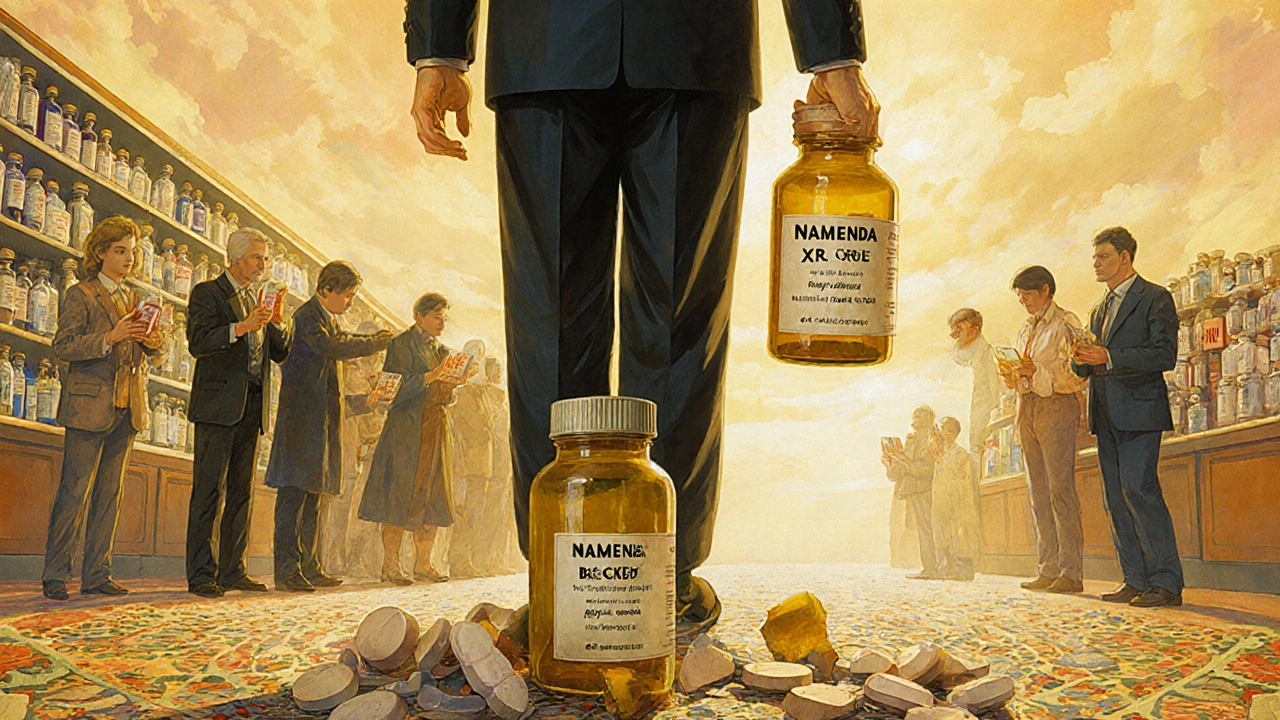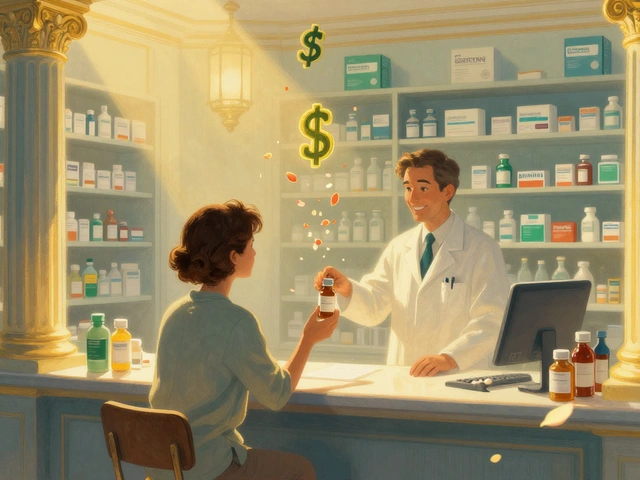When a doctor writes a prescription for a brand-name drug, most states let pharmacists swap it for a cheaper generic version - if it’s bioequivalent. That’s the law. But in recent years, big pharmaceutical companies have found ways to legally sabotage that system. They don’t fight the law head-on. Instead, they manipulate the system to make generic substitution impossible - even when the law says it should happen. This isn’t just a loophole. It’s a calculated strategy to protect profits, and it’s costing patients and taxpayers billions.
How Product Hopping Kills Generic Competition
The most common tactic is called product hopping. It works like this: a brand-name drug is about to lose its patent. Generic versions are ready to hit the market. Instead of letting the original drug compete on price, the company pulls it off shelves and replaces it with a slightly modified version - say, a slow-release pill instead of a regular tablet. They claim it’s an improvement. But in many cases, the change is tiny: a different coating, a new shape, or a slightly different release mechanism. No real medical benefit. Just enough to get a new patent. Why does this matter? Because state substitution laws only allow pharmacists to switch to generics that are bioequivalent to the original drug. If the original is gone, and only the new version is available, pharmacists can’t substitute. Patients are stuck with the expensive brand-name drug - even if it’s the exact same medicine, just packaged differently. The case of Namenda is a textbook example. In 2013, Actavis introduced Namenda XR, an extended-release version of the dementia drug. Thirty days before the original Namenda IR lost patent protection, they pulled it from the market. Generics were ready. But because the original formulation was no longer available, pharmacists couldn’t substitute. Patients had to switch to the new version - and pay three to four times more. The Second Circuit Court of Appeals ruled in 2016 that this was illegal. Why? Because it wasn’t innovation. It was sabotage.How REMS Abuse Blocks Generic Entry
Another tactic is abusing the FDA’s Risk Evaluation and Mitigation Strategies (REMS) program. REMS were created to manage serious drug risks - like with thalidomide or isotretinoin. But some companies use REMS to block generic manufacturers from getting the samples they need to prove their drug is equivalent. To get FDA approval, a generic maker must test their version against the brand-name drug. But if the brand company refuses to sell them samples - even though they’re selling it to everyone else - the generic can’t be approved. This isn’t a technicality. It’s a bottleneck. A 2017 study found that over 100 generic companies reported being denied samples. For 40 drugs under restricted access programs, this delay cost the system more than $5 billion a year in lost savings. The FTC called this a textbook case of monopolization. Why? Because the brand company isn’t trying to protect safety. They’re trying to protect profits. If they were truly worried about risk, they’d restrict access to everyone. But they don’t. They only block generics.Why Courts Are Split - And Why It Matters
Not every court sees product hopping the same way. In 2009, a court dismissed a case against AstraZeneca for switching patients from Prilosec to Nexium. Why? Because Prilosec was still on the market. Patients could still choose it. The court called Nexium a legitimate new product. But in the Namenda case, the court saw it differently. The original drug was gone. No choice. No competition. That’s what made it illegal. The difference isn’t subtle. It’s the difference between offering a better option and eliminating the old one to kill competition. In the Suboxone case, Reckitt Benckiser pulled the original tablet form and pushed a film version. They claimed the film was safer - but evidence showed they spread false rumors about the tablet being unsafe. The FTC found this was coercion. Patients didn’t switch because they wanted to. They switched because they were scared. The court agreed. Reckitt paid millions in settlements. These cases show a pattern: courts will allow new products. But they won’t allow companies to destroy the old one to prevent generics from entering.
The Financial Cost Is Staggering
The numbers don’t lie. When generics can enter freely, they capture 80-90% of the market within months. When product hopping works, that number drops to 10-20%. Take Revlimid. The price jumped from $6,000 to $24,000 per month over 20 years. Why? Because the company kept extending patents and introducing minor reformulations. A 2023 analysis found that just three drugs - Humira, Keytruda, and Revlimid - cost the U.S. system an estimated $167 billion more than they would have in Europe, where generic substitution is faster and harder to block. In the Ovcon case, a manufacturer introduced a chewable version and then stopped selling the original. The result? Generic versions couldn’t enter. Patients paid 10 times more. The FTC called it a deliberate effort to destroy the market for generics. These aren’t rare cases. They’re the norm.Who’s Fighting Back - And How
The FTC has been leading the charge. In 2022, they released a landmark report detailing 15 years of product hopping cases. They didn’t just analyze the problem - they showed how it’s been used to delay competition. The report pushed for stronger state laws and clearer federal guidelines. In the Namenda case, the FTC got a court order forcing Actavis to keep selling the original drug for 30 days after generic entry. That gave generics time to catch on. In the Suboxone case, they forced Reckitt to stop spreading false claims. State attorneys general have also stepped in. New York sued Actavis in 2014 and won an injunction. Other states are following. Even the Department of Justice has joined in - but not against brand companies. They’ve gone after generic manufacturers for price-fixing. Teva paid $225 million. Glenmark paid $30 million. That’s not hypocrisy. It’s balance. The system works when both sides play fair.
The Bigger Picture: Innovation vs. Exploitation
Pharmaceutical companies argue they’re protecting innovation. They say if they can’t profit from new versions, they won’t invest in research. But that’s not what’s happening here. Product hopping isn’t innovation. It’s legal engineering. Real innovation takes years. It involves clinical trials. It changes how a drug works. Product hopping takes months. It changes how a pill looks. The goal isn’t better health. It’s better margins. As Professor Michael Carrier put it: "The conduct literally makes no sense other than by harming generics." If a company’s only reason for changing a drug is to block cheaper versions, that’s not a business strategy. It’s an antitrust violation.What’s Next?
The FTC is pushing for legislative fixes. One idea: require companies to keep selling the original drug for six months after generic entry. Another: ban REMS abuse unless there’s a proven safety risk - not just a financial one. Congress is listening. In 2023, the House Committee on Appropriations directed the FTC to report on these practices. The Senate is considering bills to limit patent thickets and force sample access. But the real change will come from state laws. States with strong substitution rules - like California and New York - have seen faster generic entry. States with weak rules? Patients still pay more. The solution isn’t complicated. Stop letting companies destroy the old product to kill competition. Let pharmacists do their job. Let patients choose what’s cheaper. Let the market work. Because in the end, this isn’t about patents. It’s about access. And if the law can’t protect that, then the law needs to change.What is product hopping in pharmaceuticals?
Product hopping is when a brand-name drug company replaces an expiring-patent medication with a slightly modified version - like a new dosage form or delivery system - while withdrawing the original. This prevents pharmacists from substituting cheaper generics, because substitution laws only apply to the original drug. The change usually offers no real medical benefit, but it extends monopoly pricing.
How does REMS abuse block generic drugs?
REMS (Risk Evaluation and Mitigation Strategies) are safety programs meant to manage serious drug risks. Some brand companies abuse them by refusing to sell samples of their drug to generic manufacturers - even though they sell it to hospitals and pharmacies. Without those samples, generics can’t prove bioequivalence, so they can’t get FDA approval. This delays competition and keeps prices high.
Why did the court rule against Actavis in the Namenda case?
The court ruled against Actavis because they withdrew the original Namenda IR (immediate-release) tablet just 30 days before generic entry and replaced it with an extended-release version. Since the original drug was no longer available, pharmacists couldn’t substitute generics under state law. The court found this wasn’t innovation - it was an intentional tactic to block competition, which violated antitrust laws.
How much money do these tactics cost patients?
Delayed generic entry due to product hopping and REMS abuse costs U.S. consumers and taxpayers billions each year. One analysis estimated $167 billion was wasted on just three drugs - Humira, Keytruda, and Revlimid - compared to what the same drugs cost in Europe. In some cases, prices have tripled or quadrupled over two decades because generics were blocked.
Can pharmacists substitute generics if the original drug is still available?
Yes - if the original brand-name drug is still on the market and state law allows substitution, pharmacists can legally switch to a generic version. But if the brand company pulls the original drug and only offers a reformulated version, substitution is blocked. That’s why removing the original is the key move in product hopping.
What’s being done to stop these practices?
The FTC has sued companies like Actavis and Reckitt Benckiser and won injunctions and settlements. They’ve also pushed state legislatures to strengthen substitution laws. Congress is considering bills to ban REMS abuse and require brand companies to keep selling original drugs for a set time after generic entry. Some states have already passed laws to limit product hopping.







Comments
Rob Goldstein
18 November 2025Product hopping is such a blatant scam it’s almost impressive. Companies aren’t innovating-they’re playing Tetris with patents, sliding the old drug off the board just as the generics are about to drop in. And the worst part? Patients get stuck paying $200 for a pill that’s chemically identical to the $20 version they used to get. It’s not capitalism. It’s corporate extortion with a FDA stamp of approval.
And REMS abuse? Come on. If they were truly worried about safety, they’d restrict access to everyone. But no-they only block generics. That’s not risk management. That’s market manipulation dressed up in a lab coat.
Margo Utomo
18 November 2025Let’s be real-this is why I hate the American healthcare system 😤💸
They’ll spend $10M lobbying to keep a $6k/month drug expensive while people choose between insulin and rent.
And the worst part? The same CEOs who do this are the ones giving TED Talks about ‘patient-first innovation.’ 🤡
Someone please pass the popcorn… and a new law.
George Gaitara
18 November 2025You people are missing the forest for the trees. The real issue isn’t product hopping-it’s the FDA’s broken approval process. Why should generic manufacturers be allowed to skip clinical trials? That’s not ‘equivalence’-that’s shortcutting safety. If you want cheaper drugs, fix the system, not the companies. They’re just exploiting a broken regulatory environment. And before you say ‘but the drug is the same!’-did you even read the label? Different excipients. Different dissolution profiles. Different risks. You’re assuming science is binary. It’s not.
Deepali Singh
19 November 2025Interesting. But have you considered that 87% of these ‘generic’ alternatives are manufactured in India and China under questionable GMP standards? The real cost isn’t just financial-it’s in the unreported adverse events from substandard generics. Maybe the brand companies aren’t villains. Maybe they’re the only ones still holding the line on quality control. Just saying.
Sylvia Clarke
21 November 2025Let’s pause for a moment and admire the sheer audacity of this strategy: extract billions from patients by turning a pill into a political football. It’s like a magician pulling a rabbit out of a hat-except the rabbit is your paycheck, and the hat is a courtroom. And yet, somehow, we’re supposed to be impressed by the ‘innovation’? 🎩💸
Real innovation takes a decade of research. This takes a legal intern and a PowerPoint. The fact that courts are split on this isn’t a flaw in the law-it’s a reflection of how deeply entrenched this rot is. We don’t need more studies. We need a reckoning.
Jennifer Howard
22 November 2025While I appreciate the sentiment expressed herein, I must respectfully assert that the underlying premise is fundamentally flawed. The pharmaceutical industry operates under a fiduciary duty to shareholders, and the patent system was designed explicitly to incentivize innovation through temporary monopolies. To suggest that corporations should voluntarily forgo their legal rights in the interest of ‘fair pricing’ is not only economically irrational, but morally indefensible. Furthermore, the notion that ‘bioequivalence’ equates to therapeutic equivalence is a dangerous oversimplification that ignores pharmacokinetic variability, patient compliance, and the potential for adverse reactions due to excipient differences. One cannot simply equate chemical structure with clinical outcome. This is not antitrust-it is ideological overreach disguised as consumer advocacy.
Abdul Mubeen
24 November 2025Who really benefits from these ‘generic’ drugs? The FDA? The pharmacies? Or the Chinese state-owned pharma conglomerates that supply 80% of the API? This isn’t about patient access-it’s about geopolitical supply chain control. The real product hop is from American innovation to foreign manufacturing. And don’t tell me the FTC is acting in good faith. They’re just another branch of the deep state trying to break the last profitable industry left in the U.S. Wake up. This is a Trojan horse for deindustrialization.
mike tallent
24 November 2025Big Pharma’s tricks are wild, but here’s the thing: pharmacists are the unsung heroes here. They’re the ones trying to help you save money every day, and they’re stuck between a rock and a hard place. 🙌
And honestly? We need to push our reps to pass state laws that say: if a drug’s been on the market for 5+ years, the original MUST stay available for 6 months after generic approval. No excuses.
Also, if you’re on a drug that just got ‘upgraded’ and your bill jumped 3x-ask your doctor: ‘Is this actually better for me-or just more profitable for them?’
Change starts with questions. 💪
Joyce Genon
25 November 2025Okay, but let’s be honest-this whole narrative is just a recycled talking point from the same activist groups that also think vaccines cause autism and that fluoride is a government mind-control agent. The idea that a company changing the release mechanism of a drug is somehow ‘anti-competitive’ ignores the fact that every single pharmaceutical product evolves over time. The original Prilosec? Still on the market. The original Namenda IR? Withdrawn because it was outdated. That’s not sabotage-it’s progress. And if you think generics are always better, you clearly haven’t read the FDA’s own reports on bioequivalence failures. Some generics have up to a 20% variance in absorption. That’s not ‘cheaper’-that’s risky. And don’t even get me started on the fact that most of these ‘generic’ manufacturers are owned by the same conglomerates that own the brand names. So really, who’s profiting here? The same people. The whole thing is a theater. The FTC is just playing a role. And you’re all just clapping.